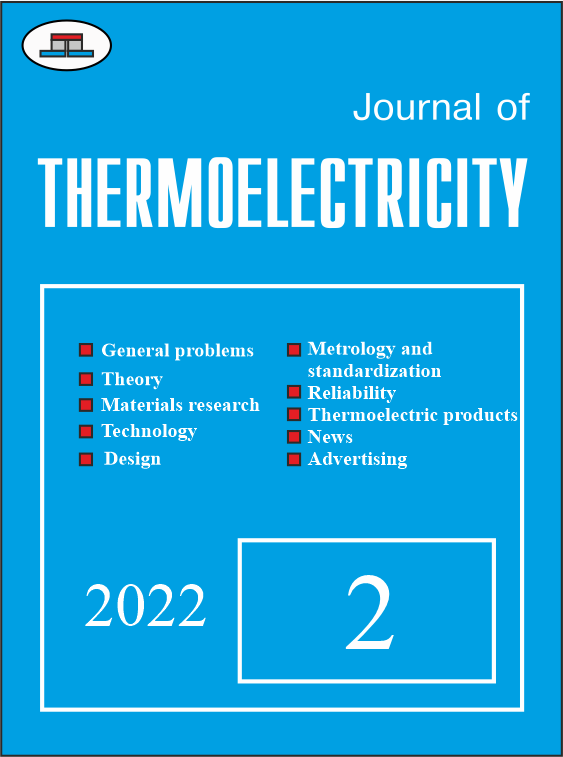Analytical calculation of the effect of metal coating of thermoelectric legs on the efficiency of generator thermoelement
DOI:
https://doi.org/10.63527/1607-8829-2022-1-18-27Keywords:
thermoelement reliability, thermoelectric leg, metal coating, shunt, thermoelectric figure of merit, effective thermoEMF, coating thickness, maximum thermoelement efficiencyAbstract
The effect of the protective metal coating of the lateral surface of thermoelectric legs on the efficiency of a generator thermoelement has been determined. At the same time, it is taken into account that the metal coating shunts the thermoelectric leg both in terms of electric current and heat flux. Theoretical calculations were made without taking into account eddy thermoelectric currents in the "thermoelectric material - protective coating" system and the temperature dependences of the characteristics of the metal and thermoelectric material for the "bismuth telluride - nickel" couple. The effects of the metal coating on the effective thermoEMF of the leg are taken into account. It is shown that when the influence of the metal coating on the thermoEMF of the leg is taken into account, the efficiency is a sharply monotonically decreasing function of the thickness of the metal coating, so that in order to achieve the efficiency of a thermoelement at a level of about 5%, the coating thickness should be no more than 0.5 µm at a leg height of 1 mm, about 0.9 µm for the leg height of 2 mm and about 1 µm with a leg height of 3 mm. In so doing, it is assumed that the electrical contact resistance is about 10-5 Ohm•cm2, and the thermal contact resistance is absent. However, in the presence of thermal contact resistance at a level of 0.8 K•cm2 /W, the efficiency of the thermoelement remains at a level of about 5.3% even with a coating thickness of 5 μm.
References
WO/2015/126272. V. I. Grishin, D. V. Kotlov. Method of manufacturing semiconductor legs for thermoelectric module and thermoelectric module.
Sabo E. P. (2006). Mechanisms that determine the resource possibilities of thermoelectric converters. J. Thermoelectricity, 2, 59 - 70.
Salvo M., Smeacetto F., D’Isanto F. et al. (2018) Glass-ceramic oxidation protection of higher manganese silicide thermoelectrics Journal of European Ceramic Society. https://doi.org/10.1016/j.jeurceramsoc.2018.01.007
US patent No US 7480984 B1 (2009). J. S. Sakamoto, T. Caillat, J.-P. Fleurial, G. J. Snyder. Method of suppressing sublimation in advanced thermoelectric devices.
Wereszczak A. A., McCarty R., Thompson, Sharp J. (2012). Thermoelectric mechanical reliability. Vehicle technologies annual merit review and peer evaluation meeting. Arlington VA. 15 May 2012.
Liu W., Jie Q., Kim H.S., Ren Z. Current progress and future challenges in thermoelectric power generation: from materials to devices. – Preprint of department of physics and Texas center for superconductivity (TcSUH) – University of Houston, Texas 77204, USA. – 60 p.
Karri N.K., Mo C. (2017). Reliable thermoelectric module design under opposing requirements from structural and thermoelectric considerations. Journal of Electronic Materials. November, 2017, 1-10. – https://doi:10.1007/s11664-017-5934-6 .
Yi Yan. (2019). Vertical self-defined thermoelectric legs for use in thin-film micro thermo electric generators (μ-TEG)/ Yi Yan . A dissertation submitted in partial fulfillment of the requirements for the degree of Doctor of Philosophy (Electrical Engineering) in the University of Michigan.
Song Lv., Liu M., Xe W. et al. (2020). Study of thermal insulation material influence on the performance of thermoelectric generators by creating a significant effective temperature difference. Energy Conversion and Management, Vol.207, 112516-1 – 112516-9.
Anatychuk L. I. (1979). Termoelementy i termoelectricheskiie ustroistva. Spravochnik. [Thermoelements and thermoelectric devices. Guidebook]. Kyiv: Naukova Dumka.
Anatychuk L. I., Kuz R. V., Luste O. J. (2005). Optimization of zone-inhomogeneous thermoelement with electrically conductive layers on isothermal faces. J.Thermoelectricity, 3, 68 - 73.




